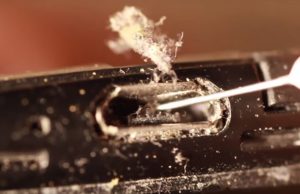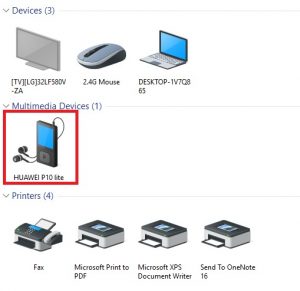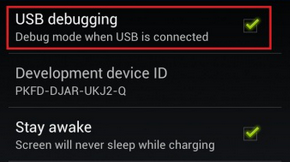How To Upload Photos To My Computer From My Samsung Tablet?
For the past years, a common trend in mobile engineering is to get wire-gratuitous. Our Android phones are capable of sending and fetching files using the cloud, connect to the net over Wi-FI, beam audio content to our headsets without the need of a cable and even charge wirelessly.
Only even if almost all Android models are perfectly capable of connecting to a PC wirelessly, near of u.s. however adopt to plug them into their PC the onetime manner mode when trying to transfer files. At that place are advantages of going with the archetype arroyo – the transfer speed is usually faster and the connectedness is, in theory, more than reliable.
Unfortunately, in reality, things don't always work as they should and your mobile device might not get detected by your PC.
Ideally, when you connect your Android device to a PC, Windows will immediately treat it equally an MTP (Media Transfer Protocol) connection and install the necessary drivers and then that it shows within File Explorer.
If yous rooted your device, used it equally an emulator for an Android Studio / Eclipse project or installed a new ROM on it, chances are you installed the ADB driver (Android Debug Bridge). This will permit your PC to send commands to your device but has the habit of tampering with the standard MTP settings, which will crusade your device to stop actualization on My computer.
But go on in mind that the ADB driver is non solely responsible for preventing your phone from showing up on PC. This problem has numerous potential causes and can appear on devices that never used the ADB driver.
With this in mind, we've created a collection of methods that volition make your telephone appear in File Explorer over again. Since the guide includes a lot of troubleshooting, nosotros ask that you start with the kickoff potential set and motility down until yous find a method that works for you.
Method 1: Restarting both devices and using another port
If you connect your Android device and nothing happens, this should be the start course of action. USB ports tin can easily get faulty, so it's unremarkably all-time to rule out the obvious stuff outset. Here's what yous need to do:
- Disconnect the cable and restart both devices.
- Once both are fully rebooted, re-connect the cable, but this fourth dimension make sure you apply a different USB.
Method 2: Employ a different USB cable
Now let's rule out the possibility of a faulty USB cablevision. USB cables don't ever intermission completely, that's why it's usually hard to identify them as the trouble.
If yous await closely inside the micro-USB port, y'all'll see a few gilt connectors. They are used for charging purposes but also facilitate the transfer of information when connected to a unlike device. It'south plenty for one or 2 to change their position or suspension for the cablevision to cease working. Chances are it will keep to charge but it won't have enough functionality to support a file transfer. Here's what you demand to do:
- Connect your phone to a different cable and run into if information technology shows upward in My Estimator.
- If it shows, your problem is solved. If it'south not showing, modify the USB port and listen closely for the Windows sound that signals new connected devices.
- If y'all hear the sound, near likely you don't have a hardware consequence and you're dealing with a commuter problem.
Method 3: Cleaning the micro-USB port
Let's brand sure there aren't whatever foreign objects that are blocking the micro-USB port, preventing the file transfer from happening. If you use to comport your phone in your pocket too much, the micro-USB port might suffer from lint aggregating. This can hinder the transfer of electricity and prevent your smartphone from exchanging data. Here's what you lot need to do:
- Utilize a flashlight to have a expect inside the micro-USB port and see if you can spot anything that shouldn't exist at that place.
Note: If yous see annihilation that shouldn't exist there, move over with the next steps. If the port is clean, start with method 4. - Make certain your device is powered off and use a small pair of tweezers, a needle or toothpick to drag any lint out of the port.

- Dip a small cotton swab in rubbing alcohol, insert information technology into the charging port and rotate information technology so that you get any of the remaining dirt out.
- Permit information technology dry for at least 2 hours before attempting to power up once more.
If you went on with the troubleshooting guides above, we successfully eliminated most hardware related problems. Now let'southward start dealing with the potential software problems.
Method four: Connecting as Storage
If your device isn't showing upward in My Reckoner, yous might be using the wrong connectedness fashion. Android knows several different modes to connect with other devices – charging only, MTP, PTP, and MIDI, amidst others. For our purpose, we need to apply an MTP connectedness. Here's what y'all need to do:
- Plug in your device to your PC.
- On your phone, pull downward the notification windows and select the MTP select. Depending on the manufacturer, this option may have different names similar Transfer files or Device File Manager.

Method 5: Updating the MTP Driver
If the methods above didn't piece of work, let's see if you're dealing with a commuter trouble. Nosotros'll start by confirming that your PC sees your Android as an MTP device.
Open Control Panel and go to Devices and Printers.If you manage to locate the name of your Android device, the MTP connectedness is working properly. If your device is named MTP or Unspecified, you'll need to update some drivers.

Fortunately, you lot can hands fix it by tweaking some settings in Device director. Here's how:
- Correct-click on my estimator and click on Device Director (Manage on Windows 10).
- Now expand Portable devices and see if your device is located there. If it doesn't contain your device's existent name or it has a xanthous exclamation mark, right-click on it and tap on Update Commuter.

Note: If the Portable devices tab is not available, look for an entry with "ADB" in the name. - The Update Commuter window will now ask you to either search for the commuter automatically or to browse your computer manually for it. Cull the latter.

- You'll be presented with a location box, only you need to click on "Let me choice from a listing of device drivers on my computer".

- Select Android Device from the long list of hardware types.

- Click on MTP USB Device to highlight information technology and then click Next.

7. The onetime driver should exist replaced with a new one. Wait until the process finishes. Your Android device should at present exist seen every bit a multimedia device in File Managing director.
Method six: Re-Installing Android Drivers
While nosotros're hither, let'south brand sure yous have the latest Android drivers installed on your PC. There's besides a slight chance your drivers might not have installed properly or have been tampered by other services such as the ADB. Hither's how to reinstall the Android drivers:
- Connect your Android to the PC and go back to Device Managing director.
- Await for your device name nether Portable Devices. If y'all don't see this entry, expect under Other devices.

- Right-click on the device and click on Uninstall.

- Later your device disappears from the list, disconnect the cablevision.
- Connect it once more and wait for Windows x to reinstall the Android drivers.
- Await to see if your device appears inside My figurer.
Method 7: Download Media Feature Pack (Windows 10 only)
If updating the MTP driver and the Android driver didn't do the pull a fast one on, maybe a different driver is the culprit. As I've stated above, your Android device uses an MTP protocol to transfer data back and forth to your PC. MTP transfer has mutual processes with Windows Media Thespian, Windows 10
MTP transfer has mutual processes with Windows Media Thespian and some versions of Windows 10 versions don't have the Media Player installed by default. In those cases, related technologies such as the MTP protocol won't work equally they should.
Luckily, this can be fixed by installing the Media Feature Pack for the N and KN versions of Windows x. Download it from here.
![]()
Method 8: Connecting as a USB Mass Storage
Some versions of Android(especially older versions) will allow y'all connect as a USB Mass Storage device. USB Mass storage doesn't employ the same drivers every bit an MTP connection. It's similar to connecting an external SD card or a flash drive to your pc. Instead of recognizing your device as an Android, your PC will treat it like mass storage volume and will mount it accordingly.
Of grade, you lot won't be able to practise things similar connecting to your smartphone PC suite, but at to the lowest degree you'll be able to move files back and forth. Hither's how:
- Get to Settings > More than Settings.
- Tap on USB utilities and then on Connect Storage to PC.
- Tap on Connect Storage to PC so on Plough on USB storage.
- Wait until it installs the needed drivers.
- On your PC, open up My Computer and run into if your Android appears as a Windows volume.
Method nine: Enabling USB Debugging
USB Debugging is meant for advanced users that test and decompile apps on real devices. Merely since it works with elevated privileges, it might just solve your problem. Hither's what yous need to do:
- Go to Settings and gyre down to the Nearly or Nearly phone entry.
- Tap on the Build Number seven times.

- Now you lot should exist able to see a new entry called Developer Pick.

- Tap on Programmer options and tap on USB debugging to enable it.

- Plug in your device and agree with the message asking to Let USB debugging on your telephone.
Source: https://appuals.com/android-phone-not-showing-up-on-pc/
Posted by: joynerjokened.blogspot.com


0 Response to "How To Upload Photos To My Computer From My Samsung Tablet?"
Post a Comment